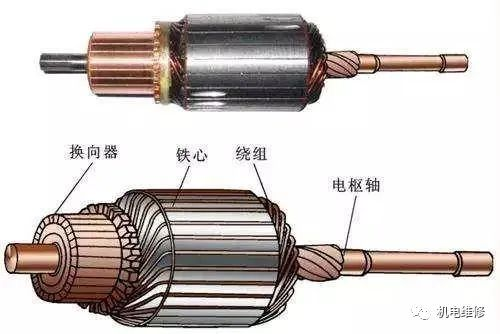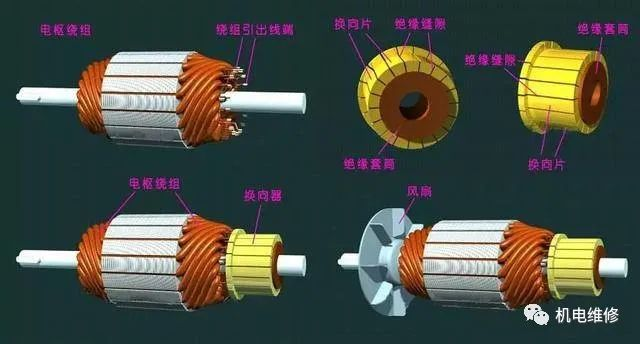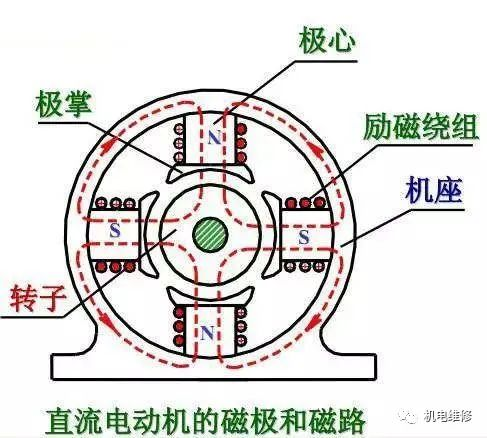The armature is the part of the motor that houses the coils, which move relative to the magnetic field. In a generator, an electromotive force is induced in a coil that is rotated by force, causing it to generate electricity. In an electric motor, the energized coil is acted upon by Ampere's force in the magnetic field, causing it to rotate in the magnetic field.
The word "armature" was first used for an inductor, the holder of a magnet.
Parts of an alternator or related equipment may be represented in either mechanical terms or electrically. Although clearly separate, these two sets of terms are often used interchangeably or contain a combination of a mechanical term and an electrical term. This can cause confusion when working with composite machines such as brushless alternators, or when talking between people who are used to working with machines of different configurations.
In most generators, the field magnet is rotating and is part of the rotor, while the armature is stationary and is part of the stator. Both motors and generators can be constructed with either a fixed armature and a rotating magnetic field or a rotating armature and a fixed magnetic field. The pole pieces of a permanent magnet or electromagnet and the moving iron part of a solenoid (especially if the latter is used as a switch or relay) may also be called armatures.

The composition of the armature
Armature windings are divided into two categories: DC armature windings and AC armature windings. They are used respectively for DC motors and AC motors.
The armature includes the armature core and the armature winding. The armature winding is the circuit part of the DC motor, and it is also the part that induces electric potential and generates electromagnetic torque for electromechanical energy conversion (the generator converts mechanical energy into electrical energy). The armature core is both a part of the main magnetic circuit and a supporting component of the armature winding. The armature winding is embedded in the slot of the armature core.
The principle of induced armature of DC motor and AC motor is roughly the same. The current in the armature winding of DC motor is also AC, and it needs to be outputted through the commutator to be DC.

AC motors are divided into induction motors (asynchronous machines) and synchronous motors. Induction motors are divided into squirrel-cage rotors and wound rotors according to the rotor structure. In induction motors, the stator windings generate a magnetic field, and the rotor windings perform electromechanical energy conversion.
In a synchronous motor, the rotor winding generates a magnetic field, and the stator winding performs electromechanical energy conversion.
The armature generally refers to the part of the motor that requires external power supply. The DC motor armature is the rotor, and the AC motor armature is the stator.

The role of armature in DC motor
In a DC motor, the armature is the part of the rotor equipped with wires that convert mechanical energy into electrical energy. A DC motor receives a DC power supply, and the armature winding is acted upon by the Ampere force in the magnetic field, generating a driving torque that drives the load to move, converting the input DC power into output mechanical energy.
For a DC generator, under the drag of the prime mover, the armature winding cuts the magnetic field lines in the magnetic field and generates an induced electromotive force. Under the rectification effect of the brush, the input mechanical energy is converted into output DC electrical energy.
When there is no current flowing through the armature winding, the magnetic field formed by the magnetic poles is called the main magnetic field, which is distributed approximately according to a sinusoidal pattern. When a current flows through the armature winding, the winding itself generates a magnetic field, which is called the armature magnetic field. The effect of the armature magnetic field on the main magnetic field will distort the main magnetic field and produce an armature reaction:
(1) Armature reaction under purely resistive load:
The electromotive force of the armature magnetic field has the same phase as the current. The armature magnetic field distorts the main magnetic field, half of which is strengthened and half of which is weakened;
(2) Armature reaction under purely inductive load:
The current of the armature magnetic field lags behind the electromotive force by 90 degrees. The electromotive force generated by the armature magnetic field is in the opposite direction to the electromotive force generated by the main magnetic field, thus weakening the main magnetic field electromotive force. This is why the voltage drops when the three-phase circuit contains inductive components; This is called the longitudinal axis demagnetization armature reaction;
(3) Armature reaction under purely capacitive load:
The current of the armature magnetic field leads the electromotive force by 90 degrees. Because the armature magnetic field is 90 degrees from the main magnetic field, the electromotive force generated by the armature magnetic field is in the same direction as the electromotive force generated by the main magnetic field, thus strengthening the main magnetic field electromotive force. This is why the three-phase circuit The reason why the terminal voltage rises when there is a capacitive element in it; this is called the vertical axis auxiliary magnetic armature reaction.



























 XINDA
XINDA